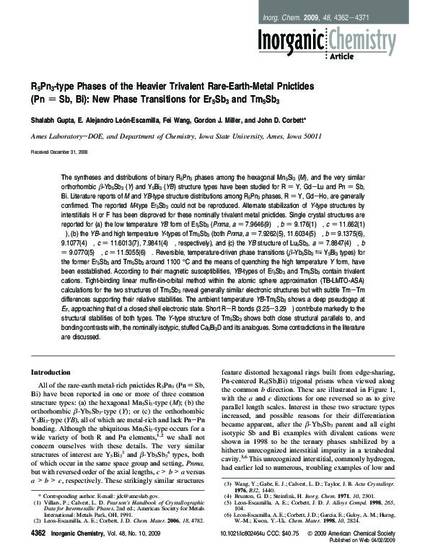
The syntheses and distributions of binary R5Pn3 phases among the hexagonal Mn5Si3 (M), and the very similar orthorhombic β-Yb5Sb3 (Y) and Y5Bi3 (YB) structure types have been studied for R = Y, Gd−Lu and Pn = Sb, Bi. Literature reports of M and YB-type structure distributions among R5Pn3 phases, R = Y, Gd−Ho, are generally confirmed. The reported M-type Er5Sb3 could not be reproduced. Alternate stabilization of Y-type structures by interstitials H or F has been disproved for these nominally trivalent metal pnictides. Single crystal structures are reported for (a) the low temperature YB form of Er5Sb3 (Pnma, a = 7.9646(9) Å, b = 9.176(1) Å, c = 11.662(1) Å), (b) the YB- and high temperature Y-types of Tm5Sb3 (both Pnma, a = 7.9262(5), 11.6034(5) Å, b = 9.1375(6), 9.1077(4) Å, c = 11.6013(7), 7.9841(4) Å, respectively), and (c) the YB structure of Lu5Sb3, a = 7.8847(4) Å, b = 9.0770(5) Å, c = 11.5055(6) Å. Reversible, temperature-driven phase transitions (β-Yb5Sb3 ⇆ Y5Bi3 types) for the former Er5Sb3 and Tm5Sb3 around 1100 °C and the means of quenching the high temperature Y form, have been esstablished. According to their magnetic susceptibilities, YB-types of Er5Sb3 and Tm5Sb3 contain trivalent cations. Tight-binding linear muffin-tin-orbital method within the atomic sphere approximation (TB-LMTO-ASA) calculations for the two structures of Tm5Sb3 reveal generally similar electronic structures but with subtle Tm−Tm differences supporting their relative stabilities. The ambient temperature YB-Tm5Sb3 shows a deep pseudogap at EF, approaching that of a closed shell electronic state. Short R−R bonds (3.25−3.29 Å) contribute markedly to the structural stabilities of both types. The Y-type structure of Tm5Sb3 shows both close structural parallels to, and bonding contrasts with, the nominally isotypic, stuffed Ca5Bi3D and its analogues. Some contradictions in the literature are discussed.
Available at: http://works.bepress.com/gordon-miller/81/

Reprinted (adapted) with permission from Inorg. Chem., 2009, 48 (10), pp 4362–4371. Copyright 2009 American Chemical Society.